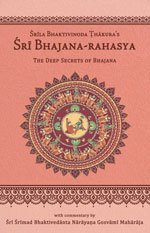Bhajana-Rahasya
by Srila Bhaktivinoda Thakura Mahasaya | 2010 | 123,965 words
The Bhajana-rahasya Text 24, English translation, including commentary (vritti). The Bhajana-rahasya is a compilation of verses describing the mercy of the eight pairs of names (Yugala-nama) of the Maha-mantra. This is text 24 belonging to the chapter “Ashtama-yama-sadhana (Ratri-lila–prema-bhajana sambhoga)” representing from midnight to three-and-a-half praharas of the night: approximately 00.00 a.m.–3.30 a.m.
Text 24
Jagannātha-vallabha-nāṭaka (3.11) describes the happiness the gopīs feel when they finally see Śrī Kṛṣṇa after being separated from Him.
In other words, it describes their condition when they meet:
यदा यातो दैवान् मधु-रिपुर् असौ लोचन-पथं तदास्माकं चेतो मदन-हतकेनाहृतम् अभूत्
पुनर् यस्मिन्न् एष क्षणम् अपि दृशोर् एति पदवीं विधास्यामस् तस्मिन्न् अखिल-घटिका रत्न-खचिताःyadā yāto daivān madhu-ripur asau locana-pathaṃ tadāsmākaṃ ceto madana-hatakenāhṛtam abhūt
punar yasminn eṣa kṣaṇam api dṛśor eti padavīṃ vidhāsyāmas tasminn akhila-ghaṭikā ratna-khacitāḥ[Śrī Rādhā said:] From the moment Śrī Kṛṣṇa, the enemy of the Madhu demon, unexpectedly came before My eyes, wicked Cupid stole My heart. Nonetheless, if He will come within My vision again, I will decorate those moments with jewels.
ye kāle vā svapane, dekhinu vaṃśī-vadane,
sei kāle āila dui vairī
‘ānanda’ āra ‘madana’, hari’ nila mora mana,
dekhite nā pāiluṅ netra bhari’पुनः यदि कोन क्षण, कराय कृष्ण दरशन,
तबे सेइ घटि क्षण-पल
दिया माल्य-चन्दन, नाना रत्न-आभरण,
अलङ्कृत करिमु सकलpunaḥ yadi kona kṣaṇa, karāya kṛṣṇa daraśana,
tabe sei ghaṭi kṣaṇa-pala
diyā mālya-candana, nānā ratna-ābharaṇa,
alaṅkṛta karimu sakala
Commentary: Bhajana-rahasya-vṛtti:
This Text, written by Śrī Rāya Rāmānanda, describes Śrī Rādhā’s deep attachment for Śrī Kṛṣṇa, which She expresses to Her intimate friend Madanikā. Her friend consoles Her, saying, “Why are You so sad? Just see! The captivating fragrance of the newly blossomed ketakī flowers attracts the bumblebee from afar. But if the bumblebee finds no honey in the flower over which it hovers, does it not abandon that flower? Similarly, You became attracted by seeing Śrī Kṛṣṇa’s lotus face, but Kṛṣṇa had no such prema. And even if Kṛṣṇa has prema, He has no understanding of how much prema You have, so it is only appropriate to give Him up.”
Śrī Rādhā contained Herself and then replied, “All right, I will now give Him up.” She shuddered, Her heart full of fear, and then, with a trembling voice, said, “O sakhī, I have given Him up as you told Me, but I cannot give up My memories of His beauty and qualities. As much as I try to forget Him, to that degree, memories arise in My mind of His gentle, soft, smiling lotus face and His reddish bimbafruit-like lips on which the vaṃśī splendidly rests. When I receive this enchanting darśana, two enemies, madana (Cupid) and ānanda (joy), appear and obstruct My vision.”
Saying this, Śrī Rādhā lost external consciousness and fainted due to Her increased longing to have Śrī Kṛṣṇa’s darśana. This longing caused an inexpressible happiness to arise in Her heart, and She was overwhelmed by a deep yearning to serve Kṛṣṇa with Her body.
Later, Śrī Rādhā said to Madanikā, “O sakhī, if Kṛṣṇa presents Himself before Me now, I will not let these two enemies, madana and ānanda, enter My heart, and I will gaze upon Him to My full satisfaction. I will decorate the moments that give Me sight of My beloved with garlands, sandalwood paste and many jewelled ornaments.”
